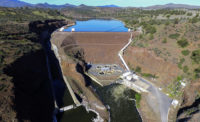Klamath River Dam Removal Pact Clears Restoration Path

On Borrowed Time Commissioned in 1918, the 20-MW Copco 1 Dam is the oldest of four Klamath River dams to be removed. The quartet produces about 1.5% of PacificCorp’s power-generation capacity. Photo Courtesy PacifiCorp
Removal of four dams on the Klamath River in California by 2020 will close the book on one of the most intractable issues in Western environmental management. On April 6, at the mouth of the river in Klamath, Calif., representatives of federal, state, agricultural and commercial stakeholders signed an agreement that resolves long-running disputes over water rights, clearing the way for one of the largest river-restoration efforts in the United States.
The dams—J.C. Boyle in Oregon and Copco I, Copco II and Iron Gate in California—were built between 1918 and 1962 and have an aggregate hydroelectric capacity of 168 MW, about 1.5% of the power-generation capacity of PacifiCorp, the owner and operator of the plants, says spokesman Bob Gravely. “The power will be replaced with generation from the company’s other power plants or wholesale-market purchases,” he adds.
Two multiparty agreements in early 2010—the Klamath Basin Restoration Agreement (KBRA) and the Klamath Hydroelectric Settlement Agreement (KHSA)—set the stage for this month’s agreement (ENR 3/1/10 p. 14). Members of the California and Oregon delegations introduced legislation in the past two Congresses to advance the KHSA and two related Klamath agreements, but Congress adjourned last year without authorizing them. The expiration of the KBRA last December caused uncertainty in moving forward with the KHSA and the Upper Klamath Basin Comprehensive Agreement, signed in 2014, forcing the stakeholders to find an alternative path to the goal.
In February, the states of Oregon and California, PacifiCorp and the federal government agreed to amend the KHSA. “The amendments primarily shift the process for facilities removal from the responsibility of the Interior Dept. to the process administered by the Federal Energy Regulatory Commission (FERC)—the process that usually would govern decommissioning federally licensed dams,” says Gravely. The amended agreement, which was signed on April 6, focuses primarily on the dam-removal portion of the broader pact. The FERC process will use existing funding and will be on the same timeline.
“The Bureau of Reclamation has developed a cost estimate that shows the most likely cost being approximately $292 million,” says an Interior Dept. spokeswoman. “This estimate was subjected to a rigorous analytical process and an independent peer-review process.” This estimate is “significantly under the combined $450 million available for removal,” she adds. The public utility commissions in Oregon and California have approved customer surcharges to collect $200 million for dam removal from PacifiCorp, and $250 million more is identified in a bond passed by California voters in 2014, Gravely explains. PacifiCorp’s funds will be used before tapping California’s. Thus, if the Bureau of Reclamation estimate is correct, California will provide $92 million of the total.
“The final decision on whether to remove dams will be with FERC,” says Nancy Vogel, spokeswoman for the California Natural Resources Agency. “The parties intend to file the settlement with FERC by July 1, 2016. The parties are asking FERC to approve this legal settlement, which includes the transfer of title from PacifiCorp to a dam-removal entity known as the Klamath River Renewal Corp. FERC will undertake its normal process for evaluating dam removal.”
The dams “block steelhead and chinook salmon from reaching the southern Oregon Klamath Tribes that have depended upon the fish for thousands of years,” Vogel says. “By reopening 300 miles of spawning grounds, dam removal would help revitalize a salmon run crucial to tribes in California and the fishing industry along the entire West Coast.” The tribes hold water rights under treaties with the U.S. government. Ranchers and farmers also have legal rights to Klamath River water for irrigation. The tangle of claims became a major obstacle in 2002, when PacifiCorp applied to renew the licenses for its four dams on the river, setting off the disputes that this month’s agreement aims to settle.





